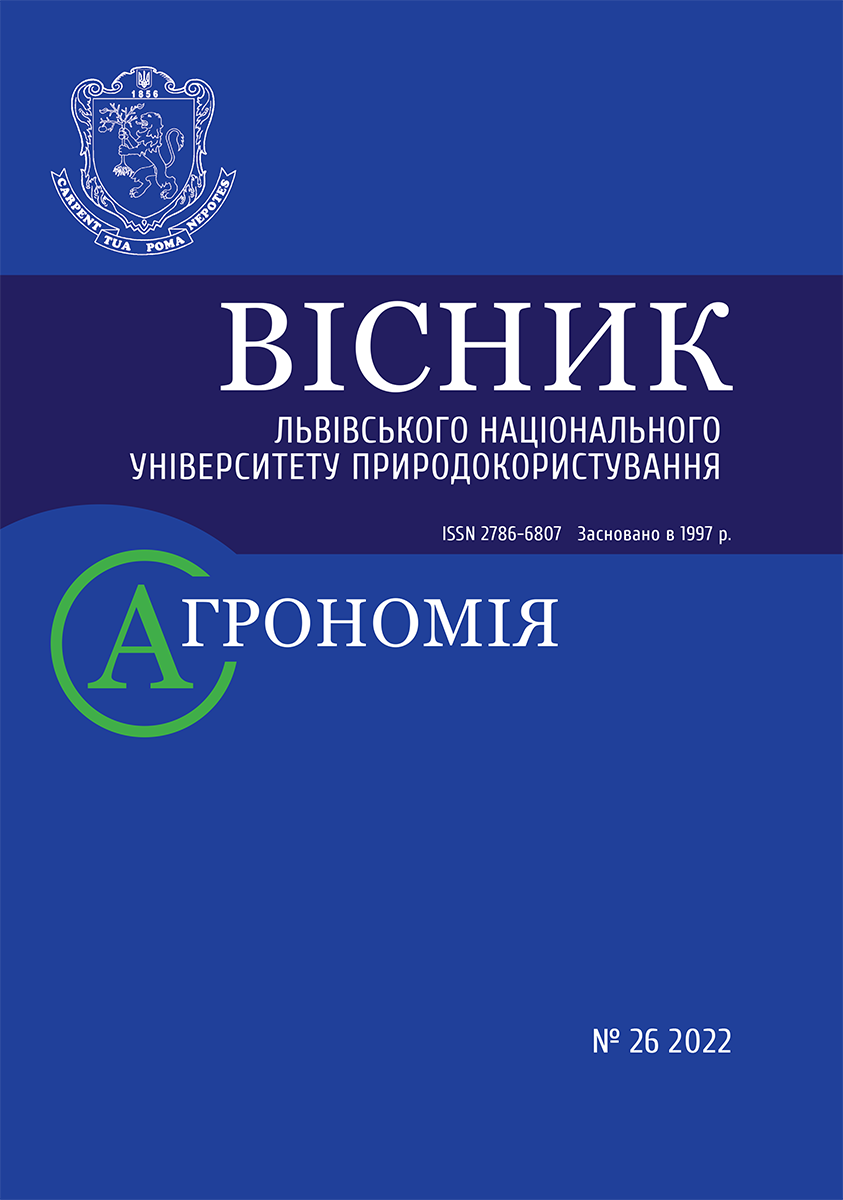ADAPTIVE SYSTEM OF THE BASIC TILLAGE FOR WINTER WHEAT
DOI:
https://doi.org/10.31734/agronomy2022.26.187Keywords:
mineral and organo-mineral fertilizers, yield, quality, profitabilityAbstract
The results of the research on the impact of the main production system based on mineral and organo-mineral fertilizers on the yield and quality of wheat grain are presented.
The research was conducted during 2009–2021 at a stationary two-factor study field, and included 4 alternative systems of the main substantiation work (shelf, flat, chisel, disk) and two coordination systems: traditional (mineral, background 1) – N60Р60К60 + N30 (feeding) and new (organo-mineral, 2) – white mustard straw + N10/t of straw + N30Р30К30 + N30 (fertilization) in short-rotation 4-joint crop rotation with the following crop growth: soybean, spring barley, white mustard, winter wheat.
Soil – chernozem podzolic, medium loam. The content of humus – 2.62–3.12 %, total nitrogen – 0.150–0.163 %, mobile phosphorus – 12.5–19.6 and potassium – 6.5–7.2 mg per 100 g of soil, pH (salt) – 6.0–6.5. Location of plots – systematic. The examined area of the site is 40 m2, the repetition of the study is four times.
On the background of mineral fertilizers, the highest yield of wheat (5.67 t/ha) is obtained for a different system of basic tillage.
It was found that the use of mineral fertilizer Nitroamophoska in a dose of N60Р60К60 for winter wheat with the organo-mineral fertilizers, where on the background of crop residues of straw straw previously made mineral at a dose of N30Р30К30, was not economically viable.
It is noted that on the background of organo-mineral fertilizer (joint use of straw pre-fertilizer and mineral fertilizer N30Р30К30) the highest yield of wheat (5.86 t/ha) was provided by the optimal system of basic tillage based on the depth of 20–22 cm, which can be best adapted for the crop. Under such conditions, a flat system to a depth of 25–27 cm may be acceptable.
Particularly high basic quality indicators of winter wheat grain were obtained on the background of mineral fertilizers. On both backgrounds of fertilizers in terms of quality, the advantage was in the shelf system of basic tillage, and in general, in the systems with higher yields there was an improvement in grain quality.
References
Balabukh V. A. Interannual variability of convection intensity in Ukraine. Global and regional climate change / ed. V. I. Osadchego. Kyiv, 2011. P. 161–173.
Bondar H. Ownership of land – a great good and great responsibility. Pravda newspaper. April 16, 2002 P. 2.
Derti R. The situation of general agriculture in the world: thesis. dokl. International conference. on technology No – Till. Jubilee village. 2004
Dospiekhov B. A. Methods of field experience. Moscow, 1979. 416 p.
Khromyak V. M., Nalyvaiko V. V. Risks of crop production in the North-Eastern Steppe in connection with climate change. Bulletin of Agricultural Science. 2016. No 9. P. 17–24.
Lukin S. V. Influence of fertilizers and weather conditions on winter wheat yield. Grain farming. 2005. No 3. P. 2–4.
Marenych M. M., Mishchenko O. V., Liashenko V. V. Estimation of influence of hydrothermal conditions of cultivation on quality of grain of winter wheat. Bulletin of the Poltava State Agrarian Academy. 2010. No 3. P. 24–25.
Medvediev V. V., Ryndina T. S. Scientific prerequisites for minimizing the main tillage and prospects for its implementation in Ukraine. Bulletin of Agricultural Science. 2001. No 7. P. 5–8.
Mikhailov V. H. New plant varieties in the intensification of agriculture. Mater. International. Scientific practice. conf. «Agriculture of the XXI century - problems and solutions». Kyiv: Chabani, 1999. P. 206–208.
Modern system of tillage in field crop rotations of Kharkiv region: Recommendations of KhNAU. V. V. Dokuchaev; Inst. Of Plant Breeding named after V. Y. Yuriev UAAS. Kharkiv, 2004.
Rational land use systems. E. Dickie, P. Jasa, D. Shelton, D. Siemens. Systems and methods of rational land use. Jawa Export – Import. USA, 1999. P. 125–130.
Samets N. P., Hrytsevych Y. S. Influence of climate change on the vegetation of winter wheat in the Western Forest-Steppe. Climate change and agriculture. Challenges for agricultural science and education: II International. scientific-practical conf. Kyiv – Mykolaiv – Kherson: SI NMC «Agroosvita», 2019. P. 143–145.
Samets N. P., Kulka V. P., Shubala H. V., Burak I. M. Variety selection is the key to obtaining a high yield of winter wheat. Modern directions and achievements of selection and seed production of agricultural crops: scientific-practical. int. conf. Poltava: Poltava State Agrarian Academy, 2021. P. 12–15.
Shykula M., Demydenko O. Self-regulation of chernozem fertility in the conditions of soil-protective agriculture. Bulletin of Agricultural Science. 2001. No 4. P. 125–130.
Tarariko Y. O. Agrometeorological resources of Ukraine and technologies of their rational use. Bulletin of Agricultural Science. 2006. No 3–4. P. 29–31.
Volkodav V. V. Improvement of methods of complex assessment of varieties of grain crops on the level of their adaptability to the conditions of soil and climatic zones of Ukraine: Abstract. dis. Cand. s.-x. Science: 06.01.05. Kyiv, 1997. 24 p.
Zhuchenko A. A. Adaptive potential of cultivated plants (ecological and genetic bases). Chisinau, 1988. 767 p.


